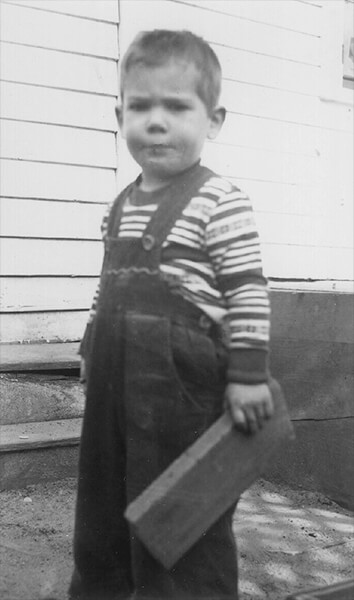
About Beautiful Boards
My name is Lawrence Berndt. I took a summer job with a custom woodworking shop in Vermont in 1975. This is when I developed a passion for Birdseye Maple. I had seen a lot of it in the floors of Vermont town halls and other older New England buildings; but it was a particular crate of window glass that really stoked my passion. The pallet under this crate had Birdseye figure so intense you could not fit another eye in the planks. It looked like a mirage. It was so striking and beautiful.
My boss let me dismantle and keep the wood from that pallet. He teased me in good fun for wanting junk wood when his racks were brimming with super clear pine, maple, and oak.
I started my own shop in 1977. I bought a lot of pine, cherry, and oak from local sawmills. I learned they sawed precious little Birdseye and Curly Maple because it was rare even then.
I started making deals to buy each mill's limited production. It was a hobby but it became my second job. I wasn’t selling it, I was just buying it because I loved it.
By 1992 I had quite a lot of it. I was getting all the production from several large and small mills in Vermont, New Hampshire, and Maine. It happened that I needed some curly cherry for a project. I bought it from a guy in New York. He was a serious supplier of curly maple to Early American furniture makers; and man he had some beautiful wood! I told him about my Birdseye stash. He introduced me to some furniture makers in NYC. They bought a nice pile of Birdseye lumber from me.
They introduced me to another wood dealer who ordered some curly maple lumber from me. This guy called me when his wood arrived. He sounded concerned at first and I thought he was upset with the lumber. He said the lumber was too good for his patrons; it would spoil them and ruin future sales. He went on to ask "Don’t your guitar customers want this wood? and at a much higher price?"
I was in the dark and stunned. "Guitars? Why would they want this kind of wood?" I asked. He was stunned that I had no guitar customers. He gave me the name of a banjo builder in California. That guy introduced me to John Page - the founding director of Fenders Custom Shop - and Ren Ferguson - head of Gibson Guitars Acoustic Custom Shop.
It was 1992 and within weeks I was buried in guitar wood orders. It soon overshadowed my woodworking business so I focused on guitar woods exclusively. I became the exclusive supplier of Birdseye and Curly rock maple to the Fender Custom Shop from 1992 to 2012.
My run with Gibson’s Acoustic Division continues today.
I was the exclusive Birdseye supplier for Lexus North America steering wheels and shift knobs for thirteen years.
I supply many boutique luthiers such as Tom Anderson, Collings Guitars, and Ernie Ball Co., as well.
I have supplied Birdseye veneer for all kinds of private jets and yachts.
I recently supplied most of the Birdseye veneer for a large project at the New York Museum of Modern Art.
It has been tremendous fun to contribute to all the music and beauty these products represent. In the process, I built a huge stash of these woods. There is less Birdseye being used by these companies now. And the supply of logs is declining also.
I have a new project now - this website, www.beautifulboards.com.
Beautiful Boards are single piece cutting boards from our Birdseye and Curly Maple lumber.
In a special process we heat treat the lumber to "set" the carbon. This fills the cell pores with carbon and the wood becomes nearly waterproof. The wood becomes even more beautiful and durable.
A PIECE OF WOOD IS A PIECE OF TIME
While most of nature is mobile and moves to seek food and shelter,
a tree must stand in place and take what comes.
Imagine standing still while bugs eat your leaves, chew holes in your bark, or lay eggs in your tenderest branch tips.
Imagine standing fast in pounding rain, heavy snow, or a blistering sun.
Imagine having to grow roots through hard soils to find water and nutrients; and twisting your branches to grow into the sunlight.
How about first some bugs move into you and then a woodpecker chops a hole in you to get them out?
Of course they stand with all the beauty, too.
The first warm breeze of spring, summer's cooling rain, the wind singing in its leaves, and the brilliant stars of a deep winter's night.
They are there as the natural world moves around and through them as time goes by.
You can see all of this in a piece of wood.
The growth rings show the lean years.
The spiral grain shows the twisting for sunlight and the force of winds.
Little bark inclusions show the scars from insects and birds.
Mineral streaks show times the roots were sending up an elixir far stronger than water.
It is all beautiful.
No wonder we love wood.
Birdseye Maple is the king of storytelling in wood.
It only develops in the most stressed Sugar Maples.
It is rare, like natural pearls, yet cannot be cultivated as pearls are.
The life of a Birdseye Maple is rough.
As a micro-percentage of the Sugar Maple population it is only found at the northernmost regions of the Sugar Maple range,
typically on a north slope with poor drainage or dry rocky soils.
The growth rings are tight and the wood is dense.
The birdseyes show in every kind of pattern.
Its beauty is reknown. It is a mainstay wood in musical instruments and the finest handmade items.
It has tales to tell and they are endlessly beautiful.
